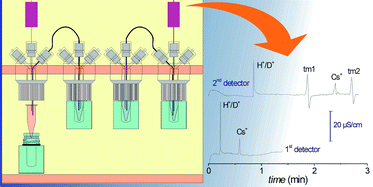Ionic mobility of the solvated proton and acid–base titration in a four-compartment capillary electrophoresis system
Abstract
Although

* Corresponding authors
a
Departamento de Química Fundamental, Instituto de Química, Universidade de São Paulo, Av. Prof. Lineu Prestes 748, São Paulo, SP, Brazil
E-mail:
claudemi@iq.usp.br
Fax: +55 11 3091-3781
Tel: +55 11 3091-3828
Although

 Please wait while we load your content...
Something went wrong. Try again?
Please wait while we load your content...
Something went wrong. Try again?
R. M. Saito, J. G. Alves Brito-Neto, F. S. Lopes, L. Blanes, E. T. da Costa, D. T. Rajh Vidal, G. M. Hotta and C. L. do Lago, Anal. Methods, 2010, 2, 164 DOI: 10.1039/B9AY00192A
To request permission to reproduce material from this article, please go to the Copyright Clearance Center request page.
If you are an author contributing to an RSC publication, you do not need to request permission provided correct acknowledgement is given.
If you are the author of this article, you do not need to request permission to reproduce figures and diagrams provided correct acknowledgement is given. If you want to reproduce the whole article in a third-party publication (excluding your thesis/dissertation for which permission is not required) please go to the Copyright Clearance Center request page.
Read more about how to correctly acknowledge RSC content.
 Fetching data from CrossRef.
Fetching data from CrossRef.
This may take some time to load.
Loading related content
